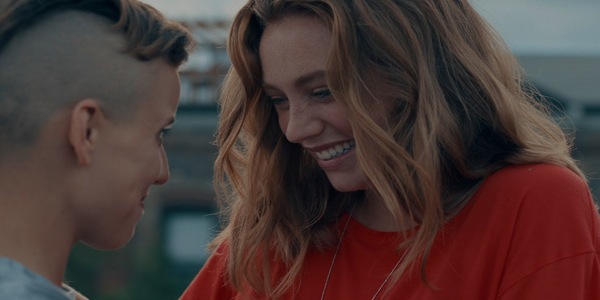Queerly Ever After #3: PRINCESS CYD (2017)

Amanda Jane Stern is an actress, writer, and director from…
Queerly Ever After is a bi-monthly column where I take a look at LGBT+ films that gave their characters a romantic happily-ever-after. There will be spoilers.
In the beautiful character-study Princess Cyd, written and directed by Stephen Cone, 17-year-old Cyd (Jessie Pinnick) spends the summer before her senior year of high school visiting her aunt, Miranda (Rebecca Spence), in Chicago; while there, she meets and falls for Katie (Malic White). The plot-line itself is nothing new, a queer take on the summer teen romance, but it’s naturalism and subtlety in favor of over-blown drama that sets it apart from other teen romances and coming-out stories.
Coming Out Without The Drama
Unlike most stories with a coming out narrative, Princess Cyd chooses not to turn that into the focal point of its story. Cyd, up until she meets Katie, has only been romantically involved with boys, she even hooks up with the son of her aunt’s friends at one point in the film, but when she meets Katie, she is immediately drawn to her. This does not cause some internal crisis or questioning of self for Cyd, she just calmly accepts it and accepts that she’s not straight. Although her sexuality is never clearly labeled in the film, Cone has expressed that she is bisexual and fluidly comfortable with that (Stephen Cone also identifies as bisexual).

After realizing she is attracted to Katie, Cyd asks her aunt if it would be weird if she were with another girl. Miranda replies that it would not be weird at all, in fact Cyd’s mother once had a relationship with another woman – “it was lovely.” From then on, Cyd decides to pursue her feelings for Katie, no shame or judgement attached. It’s refreshing to a see a film that has such a live and let live attitude to sexuality, or, to be more specific, it’s refreshing to see an American film do this. Many European films exist in what is considered the “post-gay” world and treat sexuality as just another facet of everyday life where who sleeps with whom is not important. Stephen Cone does credit a lot of European cinema, specifically the work of André Téchiné (whose film, Being 17, will also be featured in this column).
Spirituality and Sexuality
In addition to handling sexuality with grace, this film also takes on spirituality. Cyd is not spiritual, but Miranda is very deeply spiritual. In any other movie this would be another point of conflict between a young queer character and her older, religious parental figure, but Princess Cyd eschews the religion vs sexuality conflict.
The bulk of conflict that arises between Cyd and Miranda stems from them being at different points in their lives and having to learn to reconnect after years of not seeing each other. While Miranda is religious, her spiritual beliefs are personal and not something she would thrust on anyone else. Miranda herself is a fascinating character, she’s a celebrated author with a rich personal life, but as she tells Cyd, she has not had sex or been in a romantic relationship in 5 years. This confounds Cyd, who sees it as a sort of problem, a void in Miranda’s life. At one point she tells Miranda that maybe if she’d had sex recently she wouldn’t want to eat desserts all the time.

Miranda’s lack of a romantic and sex life is not however, presented as a problem. She is just not interested in that, which is fine, and she lets Cyd know that while it’s great she’s finding herself and her sexual desires, it is not okay to shame someone else for their lack of. Whether or not Miranda is supposed to be on the asexuality spectrum, she is an amazingly depicted character who does not need to be defined by a romantic story line, even though there could easily have been one.
This film is one of those instances where a man was able to create incredibly three-dimensional women without falling into any of the traps women so often fall into on screen. Its breezy treatment of sexuality, spirituality and women’s relationships in lieu of drama for drama’s sake make it a beautifully poignant piece.
In all fairness, it was the production still of Cyd in the tux that made me want to watch this film in the first place.
Princess Cyd was released in the U.S. on November 3, 2017. For all other release dates, see here.
Does content like this matter to you?
Become a Member and support film journalism. Unlock access to all of Film Inquiry`s great articles. Join a community of like-minded readers who are passionate about cinema - get access to our private members Network, give back to independent filmmakers, and more.
Amanda Jane Stern is an actress, writer, and director from New York City. She received her BA in Film, Television & Interactive Media and Theater Arts from Brandeis University. She loves regaling whomever will listen with her endless lists of fun facts and knowledge of film history. Follow her on twitter and instagram @amandajanestern












